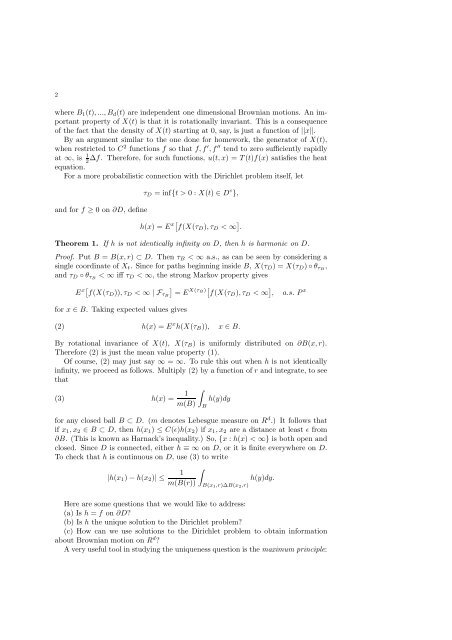Brownian Motion and the Dirichlet Problem - UCLA Department of ...
Brownian Motion and the Dirichlet Problem - UCLA Department of ...
Brownian Motion and the Dirichlet Problem - UCLA Department of ...
You also want an ePaper? Increase the reach of your titles
YUMPU automatically turns print PDFs into web optimized ePapers that Google loves.
2<br />
where B1(t), ..., Bd(t) are independent one dimensional <strong>Brownian</strong> motions. An important<br />
property <strong>of</strong> X(t) is that it is rotationally invariant. This is a consequence<br />
<strong>of</strong> <strong>the</strong> fact that <strong>the</strong> density <strong>of</strong> X(t) starting at 0, say, is just a function <strong>of</strong> ||x||.<br />
By an argument similar to <strong>the</strong> one done for homework, <strong>the</strong> generator <strong>of</strong> X(t),<br />
when restricted to C 2 functions f so that f, f ′ , f ′′ tend to zero sufficiently rapidly<br />
at ∞, is 1<br />
2∆f. Therefore, for such functions, u(t, x) = T(t)f(x) satisfies <strong>the</strong> heat<br />
equation.<br />
For a more probabilistic connection with <strong>the</strong> <strong>Dirichlet</strong> problem itself, let<br />
<strong>and</strong> for f ≥ 0 on ∂D, define<br />
τD = inf{t > 0 : X(t) ∈ D c },<br />
h(x) = E x f(X(τD), τD < ∞ .<br />
Theorem 1. If h is not identically infinity on D, <strong>the</strong>n h is harmonic on D.<br />
Pro<strong>of</strong>. Put B = B(x, r) ⊂ D. Then τB < ∞ a.s., as can be seen by considering a<br />
single coordinate <strong>of</strong> Xt. Since for paths beginning inside B, X(τD) = X(τD) ◦ θτB,<br />
<strong>and</strong> τD ◦ θτB < ∞ iff τD < ∞, <strong>the</strong> strong Markov property gives<br />
E x f(X(τD)), τD < ∞ | FτB<br />
for x ∈ B. Taking expected values gives<br />
= E X(τB) f(X(τD), τD < ∞ , a.s. P x<br />
(2) h(x) = E x h(X(τB)), x ∈ B.<br />
By rotational invariance <strong>of</strong> X(t), X(τB) is uniformly distributed on ∂B(x, r).<br />
Therefore (2) is just <strong>the</strong> mean value property (1).<br />
Of course, (2) may just say ∞ = ∞. To rule this out when h is not identically<br />
infinity, we proceed as follows. Multiply (2) by a function <strong>of</strong> r <strong>and</strong> integrate, to see<br />
that<br />
(3) h(x) = 1<br />
m(B)<br />
<br />
B<br />
h(y)dy<br />
for any closed ball B ⊂ D. (m denotes Lebesgue measure on Rd .) It follows that<br />
if x1, x2 ∈ B ⊂ D, <strong>the</strong>n h(x1) ≤ C(ǫ)h(x2) if x1, x2 are a distance at least ǫ from<br />
∂B. (This is known as Harnack’s inequality.) So, {x : h(x) < ∞} is both open <strong>and</strong><br />
closed. Since D is connected, ei<strong>the</strong>r h ≡ ∞ on D, or it is finite everywhere on D.<br />
To check that h is continuous on D, use (3) to write<br />
|h(x1) − h(x2)| ≤<br />
1<br />
m(B(r))<br />
<br />
B(x1,r)∆B(x2,r)<br />
h(y)dy.<br />
Here are some questions that we would like to address:<br />
(a) Is h = f on ∂D?<br />
(b) Is h <strong>the</strong> unique solution to <strong>the</strong> <strong>Dirichlet</strong> problem?<br />
(c) How can we use solutions to <strong>the</strong> <strong>Dirichlet</strong> problem to obtain information<br />
about <strong>Brownian</strong> motion on R d ?<br />
A very useful tool in studying <strong>the</strong> uniqueness question is <strong>the</strong> maximum principle:
















